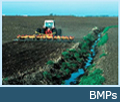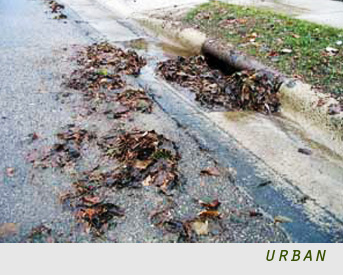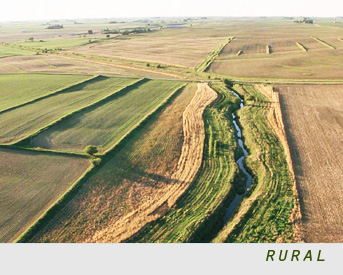        |
|
"There is too little public recognition of how much we all depend upon farmers as stewards of our soil, water, and wildlife resources." - John F. Kennedy |
The Economics of Clean Water - Rural & Agricultural "From a farmer's point of view, economics is most important because if you are not economically sustainable, you can't do anything at all,” California Farm Bureau Federation delegate and winegrape grower Bruce Fry said. Fry participates in the Lodi Rules for Sustainable Winegrowing program and has implemented a variety of ecologically based practices to improve soil and water quality, enhance wildlife habitat and ecosystem health, and reduce pesticide use. "Sustainability does resonate and it is going to be a huge thing in the marketplace going forward." Aaron Lange of Lange Twins Winery in San Joaquin County, also of the Lodi sustainability program, said. "People want to buy a bottle of wine or a food product that matches with their own values. It means being economically viable, sustainable, environmentally friendly, and fair to your community. Consumers are looking for those values and they are looking for products that embrace those values." (from Ag Alert, California Farm Bureau Federation, Dec 24, 2008) ................................................................... • Based on 2000 market prices, hay and other perennial plant enterprises are more profitable in the study areas than corn and soybeans. However, federal subsidies often make it uneconomical to raise anything other than corn and soybeans. That is a significant disincentive for diversifying farming operations. Society needs to replace those subsidies with incentives for creating public goods. • Based on a $20-per-ton “price” for storing carbon to reduce greenhouse gas emissions, the average Minnesota crop farm (318 acres) could receive $1,000 per year for using conservation tillage. Pasture and grazing systems should benefit even more because they hold even greater potential for capturing and retaining carbon in the soils. • On average, Minnesota citizens are willing to pay an additional $201 per household annually for specific and substantial public benefits that are produced under diversified land use and farming system. (Note: This was further illustrated by the passage of the Clean Water, Land & Legacy Amendment in November 2008, which calls for three-eighths of one percent increase in the sales & use tax until 2034 to protect the state’s water, natural & cultural resources.) To read more, check out "Environmental beneficial management practices provide ecenomic benefits for producers" Best Management Practices for Farmers & Rural Landowners
Agriculture's Contribution to Habitat & Conservation in Minnesota - Minnesota is a conservation leader and as this factsheer from the MN Dept. of Agriculture and Farm Bureau illustrates, agriculture and conservation go together! ..................................... Nutrient Management & Soil Testing - As of the end of 2008, 35% of the cropland in the Crystal Loon Mills watershed was enrolled in a nutrient management planning or soil testing program through the Clean Water Partnership and Clean Water Legacy programs. Precision (or variable) rate nutrient application allows the producer to apply fertilizer only in areas where it is needed – saving money on inputs, reducing runoff from excess nutrients, and helping improve farm-management decisions. To read more, follow the links below. Precision Agriculture: The Effect of Variable Rate Fertilizer Application on Soil Test Values - from Soil Science News & Views (Kentucky Cooperative Extension Services) Economics of variable rate fertilizer appliication- presented at the 2002 Energy Efficiency and Agricultureal Engineering International Scientific Conference ..................................... Wetland Restorations - Wetlands provide essential ecosystem services like improving water quality and reducing flood damage, as well as offering habitat for wildlife, recreational opportunities, and aesthetic value. For more information on wetland restorations and programs available to help landowners restore wetlands on their property, check out the links below. Agriculture's Contribution to Restoring Minnesota's Wetlands - Minnesota is a conservation leader and as this factsheet from the MN Dept. of Agriculture and Farm Bureau illustrates, agriculture and wetlands go together too! Wetland Restoration Techniques - from Private Land Partnerships (Michigan United Conservation Clubs) offers information on what a wetland restoration is, design recommendations, and maintenance tips. Wetland Restoration, Creation , and Enhancement - This Introduction and User's Guide from National Oceanic & Atmospheric Administration and EPA just might be the definitive guide to restorations (it's 96 pages long!) - With background on wetland restorations, information on project planning, implementation, and monitoring and complete with a list of resources, contacts, and funding sources it has answers to almost any question. ..................................... Vetetative Buffers - Buffer strips help prevent erosion and protect valuable land. They also provide habitat for wildlife such as pheasants, songbirds and sometimes deer. To read more, check out this these resources. Buffer Strips: Common Sense Conservation - this website from NRCS provides key points of interest about buffer strips and fact sheets about the different USDA cost-share programs available to producers. Vegetation Buffer Strips in Agricultural Areas - from DNR Waters.
|
||
|
  |

